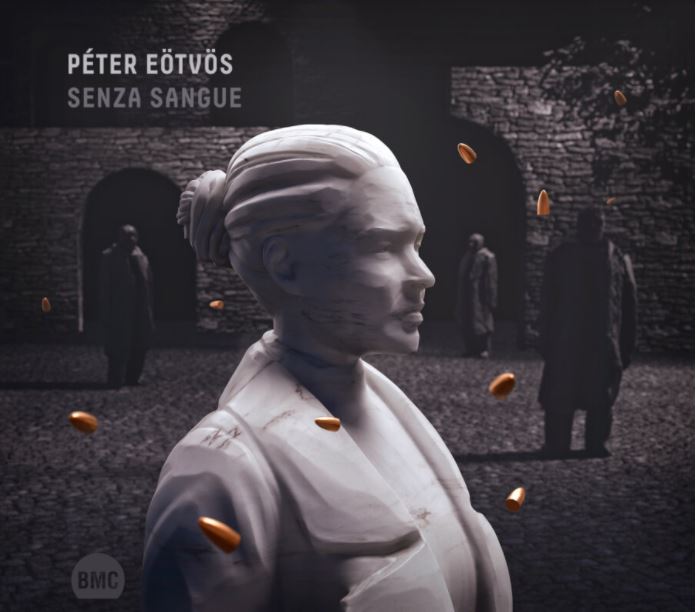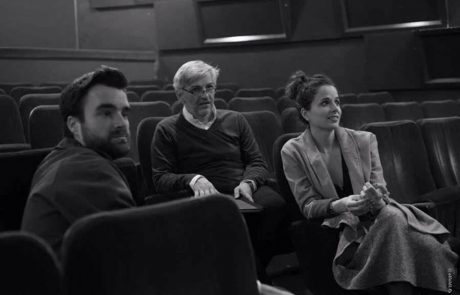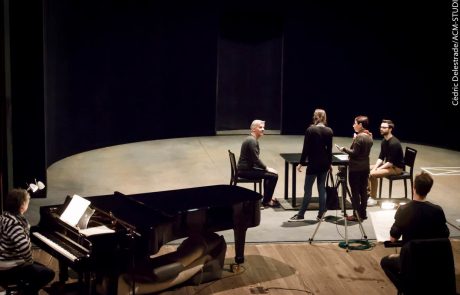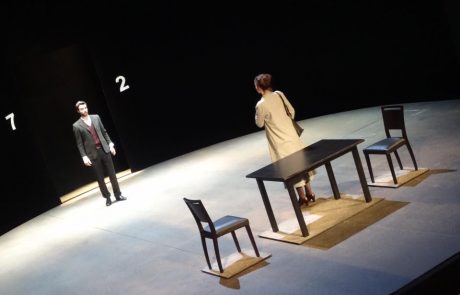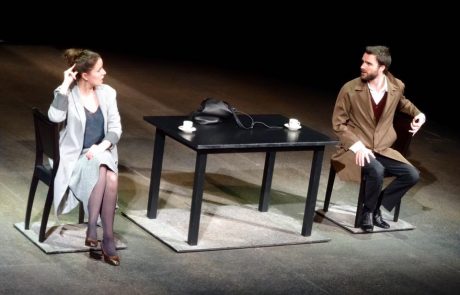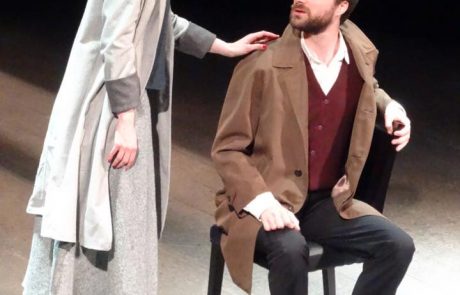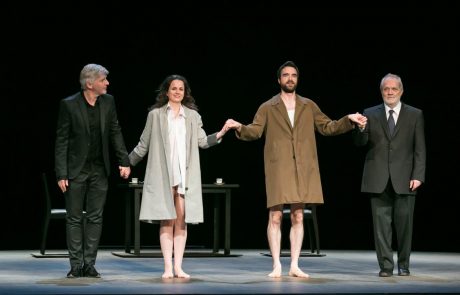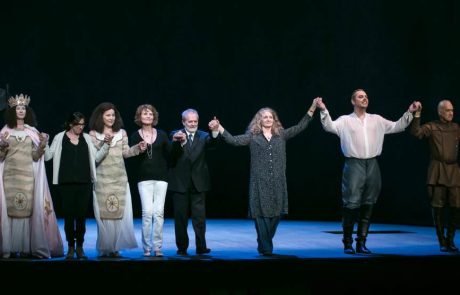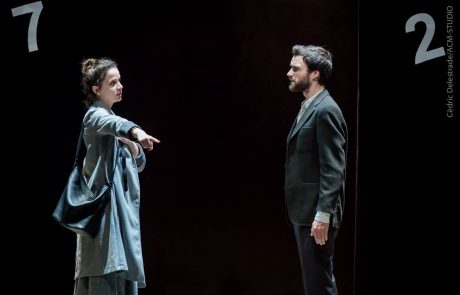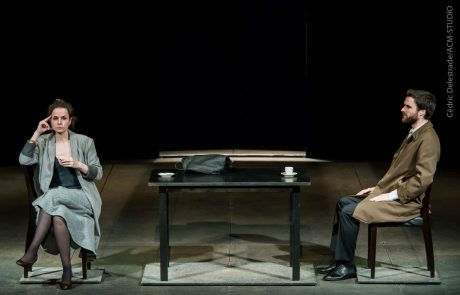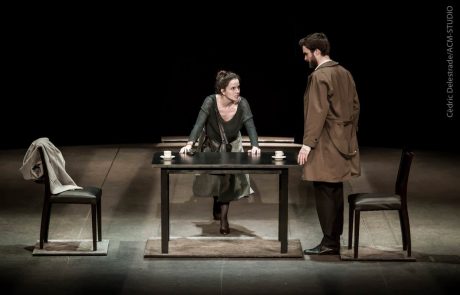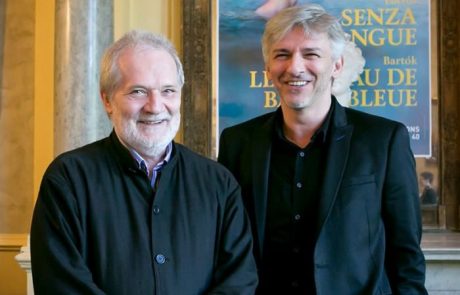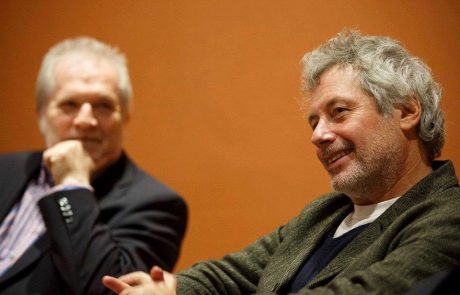Senza sangue
Opera in one act
for two singers and orchestra
Commissioned by New York Philharmonic, KölnMusik GmbH
Description
World premieres:
1 May, 2015 – Cologne
8 May, 2015 – New York, USA
New York Philharmonic Orchestra
Conductor: Alan Gilbert
Anne Sofie von Otter, Russell Braun
Scenic version:
15 May 2016, Avignon, France
Orch. Opera Grand Avignon
Conductor: Peter Eötvös
Staging: Róbert Alföldi
Albane Carrère, Romain Bockler
Libretto: Mari Mezei (based on the novel of Alessandro Baricco)
Language: Italian
“Bartók’ Bluebeard’s Castle is one of the most frequently staged operas. As this one-act work lasts only for about 60 minutes, another one-act piece is to be performed before it, as Bartók’s opera can only be followed by complete silence, a retreat into ourselves.
All nights at the opera must constitute a single unit, which is a given with multi-act pieces. For this reason, juxtaposing Bluebeard’s Castle against a musically or theatrically contrasting work would be a big mistake. As there was no existing composition available, for about 10-15 years I was searching for a literary work that could make a single dramaturgical unit with Béla Balázs and Bartók’s piece.
Both operas concentrate on the relationship between Man and Woman. It is only them present on the stage. Similarly to Bluebeard’s Castle, I divided my piece into seven scenes and maintained the symphony orchestra used previously by Bartók, which ensures a uniform timbre and allows the two operas to be performed without an intermission, if required.
The musical style of Senza sangue is autonomous, the timbres connect to Bartók’s music with a dramatic force, similar to that of black and white movies, and its last bars prepare for the beginning of Bluebeard’s Castle also in their tonality.
Bartók’s composition has a symbolic setting: the castle of the soul, while Senza sangue has a specific and tangible setting. Both pieces start with the encounter of Man and Woman, but their endings differ: while Bluebeard’s Castle ends with separation, Senza sangue is concluded with unity.
My piece is based on Alessandro Baricco’s novel of the same title published in 2002. Mari Mezei’s script places the emphasis on the second part of the book, the moment of the actual encounter. The background story comes to light only through the dialogues. Revealing and clarifying the past is essential for the Woman in both operas, but while in Bluebeard’s Castle, it is the Man’s secret past that is to be unveiled, in Senza sangue, it is the Woman’s mysterious life that needs to be understood and redeemed. In Baricco’s novel, a commando of three men assassinates the Woman’s family after a civil war. The youngest member of the commando, however, spares the life of the 12-year old daughter of the family, who will find her saviour of 72 years after a 50-year long search. The Woman is also connected to the death of the other two members of the commando in an obscure way. While evoking their dramatic past, it becomes obvious that the Woman did not come to take revenge after her long quest but to be saved by the Man one more time, to tie a knot, which will eventually turn out to be a redemption for both of them.
Even though Senza sangue does not use any musical element from Bluebeard’s Castle, blood certainly represents a point they both share. While in Bartók’s piece, the musical symbol standing for blood is a poignant minor 2nd interval, which is present in every scene, the turning point in the plot of Senza sangue is the moment when the tension of the minor 2nd interval is resolved, and the relationship between Man and Woman is at last “without blood”.”
/Peter Eötvös/
Synopsis
The protagonist of the story Nina escapes the murderers of her bother and father as a young girl by seeking shelter in a hole in the ground. One of the attackers notices her, but does not betray her. Decades later the girl meets the man in a lottery shop. The recognition terrifies him. His fellow murderers are long dead and the circumstances of their deaths were not clear: will Pedro be the next? The original text of the novel was shaped by Eötvös’ constant creative partner and wife, Maria Mezei. She created a libretto that has the cross-examination and mutual understanding of the female and male protagonist’s trauma in its main focus. The opera begins with the meeting of the two main characters and with flashbacks of the murders. The viewer does not know whether the woman is actually behind the deaths of the man’s accomplices, nor what her next step is going to be.
Scene I. A 72-year-old vendor of lottery tickets is approached by a woman in her sixties who says she wants to buy a ticket. Very soon, however, it turns out that this is only a pretext. These two obviously have a long history together. They haven’t seen each other in decades, yet they instantly recognize each other. The Woman persuades the Man to close his kiosque and have a cup of coffee with her.
Performances
Eötvös: Senza sangue
Eötvös: Senza sangue
Eötvös: Senza sangue
Eötvös: Senza sangue
Eötvös: Senza sangue
Eötvös: Senza sangue
Eötvös: Senza sangue
Eötvös: Senza sangue
New staging
Eötvös: Senza Sangue
Eötvös: Senza sangue,
Bartók: Blubeard's Castle
Cond: Peter Eötvös
Porto Symphony Orchestra Casa do Música
Eötvös: Senza sangue
Eötvös: Senza sangue - opera, concert version
Bartók: Bluebeard´s Castle
Viktoria Vizin, vcl
Jordan Shanahan, vcl
Conductor: Peter Eötvös
Brussel Philharmonic Orchestra
Place Flagey
Eötvös: Senza sangue
Eötvös: Senza sangue - opera, concert version
Bartók: Bluebeard´s Castle
Viktoria Vizin, vcl
Jordan Shanahan, vcl
Conductor: Peter Eötvös
Brussel Philharmonic Orchestra
Place Flagey
Eötvös: Senza Sangue
concert version
Opera Festival
La donna: Andrea Meláth
L´uomo: Csaba Szegedi
Conductor: Peter Eötvös
State Opera House
Eötvös: Senza Sangue
concert version
Opera Festival
La donna: Andrea Meláth
L´uomo: Csaba Szegedi
Conductor: Peter Eötvös
State Opera House
Eötvös: Senza Sangue
concert version
Opera Festival
La donna: Andrea Meláth
L´uomo: Csaba Szegedi
Conductor: Peter Eötvös
State Opera House
Senza Sangue
Venue: Staatsoper Hamburg
Stage version
Director and Set Designer: Dmitri Tcherniakov
Costume Designer: Elena Zaytseva
Lighting Designer: Gleb Filshtinsky
Dramaturgie: Johannes Blum
Video: Tieni Burkhalter
Conductors: Peter Eötvös, Gregory Vajda
La donna: Angela Denoke
L'uomo: Sergei Leiferkus
Senza Sangue
Venue: Staatsoper Hamburg
Stage version
Director and Set Designer: Dmitri Tcherniakov
Costume Designer: Elena Zaytseva
Lighting Designer: Gleb Filshtinsky
Dramaturgie: Johannes Blum
Video: Tieni Burkhalter
Conductors: Peter Eötvös, Gregory Vajda
La donna: Angela Denoke
L'uomo: Sergei Leiferkus
Eötvös: Senza sangue
Stage version
Director and Set Designer: Dmitri Tcherniakov
Costume Designer: Elena Zaytseva
Lighting Designer: Gleb Filshtinsky
Dramaturgie: Johannes Blum
Video: Tieni Burkhalter
La donna: Angela Denoke
L'uomo: Sergei Leiferkus
Conductors: Peter Eötvös, Gregory Vajda
Staatsoper Hamburg
Eötvös: Senza sangue
Stage version
Director and Set Designer: Dmitri Tcherniakov
Costume Designer: Elena Zaytseva
Lighting Designer: Gleb Filshtinsky
Dramaturgie: Johannes Blum
Video: Tieni Burkhalter
La donna: Angela Denoke
L'uomo: Sergei Leiferkus
Conductors: Peter Eötvös, Gregory Vajda
Staatsoper Hamburg
Eötvös: Senza Sangue
Stage version at Müpa
Stage Director: Csaba Káel
La donna: Viktória Vizin
L'uomo: Jordan Shanahan
Conductor: Peter Eötvös
National Philharmonic Orchestra
Eötvös: Senza Sangue
stage version
Stage director, light: Robert Alföldi
Stage: Emmanuelle Favre
Costume: Danièle Barraud
La femme: Albane Carrère
L’homme: Romain Bockler
Conductor: Peter Eötvös
Pannon Philharmonic Orchestra
Hackney Empire Theater
Eötvös: Senza Sangue
English premiere
London 10 March, 2017
concert version
BBC Symphony Orchestra London
Conductor: Simone Young
Cast:
La femme: Albane Carrère
L’homme: Russell Braun
Eötvös: Senza Sangue
concert version
Conductor: Peter Eötvös
Santa Cecilia Orchestra
Cast:
La femme: Sonia Ganassi
L’homme: Russell Braun
Auditorium Roma
Eötvös: Senza Sangue
concert version
Conductor: Peter Eötvös
Santa Cecilia Orchestra
Cast:
La femme: Sonia Ganassi
L’homme: Russell Braun
Auditorium Roma
Eötvös: Senza Sangue
Italian premiere
concert version
Conductor Peter Eötvös
Santa Cecilia Orchestra
Cast:
La femme: Sonia Ganassi
L’homme: Russell Braun
Auditorium Roma
Eötvös: Senza Sangue
Staatsoper Hamburg
Stage version
Director and Set Designer: Dmitri Tcherniakov
Costume Designer: Elena Zaytseva
Lighting Designer: Gleb Filshtinsky
Dramaturgie: Johannes Blum
Video: Tieni Burkhalter
Conductor: Gregory Vajda
Cast:
La donna: Angela Denoke
L'uomo: Sergei Leiferkus
Eötvös: Senza Sangue
Stage version
Director and Set Designer: Dmitri Tcherniakov
Costume Designer: Elena Zaytseva
Lighting Designer: Gleb Filshtinsky
Dramaturgie: Johannes Blum
Video: Tieni Burkhalter
Conductor: Peter Eötvös
Cast:
La donna: Angela Denoke
L'uomo: Sergei Leiferkus
Staatsoper Hamburg
Eötvös: Senza Sangue
Staatsoper Hamburg
Stage version
Director and Set Designer: Dmitri Tcherniakov
Costume Designer: Elena Zaytseva
Lighting Designer: Gleb Filshtinsky
Dramaturgie: Johannes Blum
Video: Tieni Burkhalter
Conductor: Gregory Vajda
Cast:
La donna: Angela Denoke
L'uomo: Sergei Leiferkus
Eötvös: Senza Sangue
Stage version
Director and Set Designer: Dmitri Tcherniakov
Costume Designer: Elena Zaytseva
Lighting Designer: Gleb Filshtinsky
Dramaturgie: Johannes Blum
Video: Tieni Burkhalter
Conductor: Peter Eötvös
Cast:
La donna: Angela Denoke
L'uomo: Sergei Leiferkus
Staatsoper Hamburg
Eötvös: Senza Sangue
Staatsoper Hamburg
Stage version
Director and Set Designer: Dmitri Tcherniakov
Costume Designer: Elena Zaytseva
Lighting Designer: Gleb Filshtinsky
Dramaturgie: Johannes Blum
Video: Tieni Burkhalter
Conductor: Gregory Vajda
Cast:
La donna: Angela Denoke
L'uomo: Sergei Leiferkus
Eötvös: Senza Sangue
Stage version
Director and Set Designer: Dmitri Tcherniakov
Costume Designer: Elena Zaytseva
Lighting Designer: Gleb Filshtinsky
Dramaturgie: Johannes Blum
Video: Tieni Burkhalter
Conductor: Peter Eötvös
Cast:
La donna: Angela Denoke
L'uomo: Sergei Leiferkus
Staatsoper Hamburg
Eötvös: Senza Sangue
Stage version
Director and Set Designer: Dmitri Tcherniakov
Costume Designer: Elena Zaytseva
Lighting Designer: Gleb Filshtinsky
Dramaturgie: Johannes Blum
Video: Tieni Burkhalter
Conductor: Peter Eötvös
Cast:
La donna: Angela Denoke
L'uomo: Sergei Leiferkus
Staatsoper Hamburg
Eötvös: Senza Sangue
Hungarian premiere
Armel Festival
Venue: National Theater Budapest
Stage version
Pannon Phiharmonic Orchestra
Stage director, light: Robert Alföldi
Stage: Emmanuelle Favre
Costume: Danièle Barraud
Conductor: Peter Eötvös
Cast:
La femme: Albane Carrère
L’homme: Romain Bockler
Eötvös: Senza Sangue
Opera Grand Avignon
Stage version
Orchestre Regional Avigon
Stage director, light: Robert Alföldi
Stage: Emmanuelle Favre
Costume: Danièle Barraud
Conductor: Peter Eötvös
Cast:
La femme: Albane Carrère
L’homme: Romain Bockler
Eötvös: Senza Sangue
French premiere
Opera Grand Avignon
Stage version
Orchestre Regional Avigon
Stage director, light: Robert Alföldi
Stage: Emmanuelle Favre
Costume: Danièle Barraud
Conductor: Peter Eötvös
Cast:
La femme: Albane Carrère
L’homme: Romain Bockler
Senza sangue - World Premiere (Cologne)
German premiere
1 May, 2016 Cologne Philharmonia, Germany
New York Philharmonic Orchestra,
Conductor: Alan Gilbert
Singers: Anne Sofie von Otter, Russell Braun
Eötvös: Senza Sangue
half-staged version
Stage director: Eva-Maria Melbye
Cast:
La femme: Albane Carrère
L’homme: Russell Braun
Conductor: Peter Eötvös
Gothenburg Symphony Orchestra
Eötvös: Senza Sangue
Swedish premiere
half-staged version
Stage director: Eva-Maria Melbye
Cast:
La femme: Albane Carrère
L’homme: Russell Braun
Conductor: Peter Eötvös
Gothenburg Symphony Orchestra
Eötvös: Senza Sangue
New York Philharmonic
cond. Alan Gilbert
Cologne Philharmonia
Anne Sofie von Otter, Russell Braun
Eötvös: Senza Sangue
New York Philharmonic
cond. Alan Gilbert
Cologne Philharmonia
Anne Sofie von Otter, Russell Braun
Eötvös: Senza Sangue
New York Philharmonic
cond. Alan Gilbert
Cologne Philharmonia
Anne Sofie von Otter, Russell Braun
Details
Publisher information
Schott Music Mainz
Cast
Donna: mezzo-soprano
Uomo: lyric baritone
Personal comments for the performance of Senza sangue
The opera commences with two calm notes: B – D, which in Hungarian and in German are spelt H–D,
the initials of the name Henry Dutilleux.
It was he who in 2011 recommended the New York Philharmonic get in contact with me, and together
with the Cologne Philharmonie they commissioned a work from me.
I had long been tempted by the idea of writing a one-act opera to go before Bartók’s Bluebeard’s Castle, to which in spirit, style, and dramaturgy it would be related. When I received the commission, and the orchestra accepted my suggestion that instead of an orchestral work I write a one-act opera, my old plan could be realized.
Dutilleux passed away in 2013, and my opera is written in his memory.
I feel that with the librettist Mari Mezei we found in the short story Senza sangue by Alessandro Baricco a situation which has many points of reference with Bluebeard but is completely independent from it.
Senza sangue is my tenth opera, and I prepared for it like a film director who decides he’s going to shoot his next film in black-and-white. In my previous operas I strove for a colourful palette of sound, but here
I aim for sharp contrasts, and shades of black, grey, and white.
The instrumentation is (except for the organ) identical to that of Bluebeard. There are two reasons for this: my hope is that Senza sangue will be performed in opera houses before Bluebeard. There is a practical advantage in rehearsals and performances if the same musicians play and the orchestra pit doesn’t have to be reorganized.
The other reason is that in the orchestral material, rather than polyphony I have emphasized a mass of sound: many instruments play the same line, creating a weighty sound, like a stroke in Japanese calligraphy, where a single black line is drawn with a thick brush.
As well as the orchestral sound I composed the vocal parts with vigorous gestures, as was the expressive style in black-and-white films.
For the most part I have retained Baricco’s original text, so this opera is sung in Italian. As in all of my operas, it is very important for me that the text should remain completely intelligible, that the melodies support, form, and give tension to the text. This is a theatrical approach, but for me opera too is no less than theater.
The two elderly protagonists of this opera, the Woman and the Man, have been preparing all their lives for this meeting. It is thus understandable that every sentence is full of tension and the relationship between them changes continuously – another way in which it resembles Bluebeard. A further similarity is that I too have divided the plot into seven scenes. The tension of the scenes forms a contour of waves, coming to a climax in scene six, and finally at the end of the opera takes a surprising turn in the form of a bashful confession of love.
The closing moments of Bluebeard lead us into the eternal darkness. In Senza sangue, for the couple at the final stage of their lives perhaps light is now dawning.
/Péter Eötvös – 2015/
Orchestration

4 flutes (2nd also altflute, 3rd and 4th also piccolo)
2 oboes
1 english horn
3 clarinets in A (3rd also bassclar.)
3 bassoons
1 contrabassoon
4 horns in F
4 trumpets in B (4th also Flugelhorn)
3 trombones
1 basstrombone
1 tuba
2 harp
1 celesta
3 timpani (one player)
2 percussion
Strings: 12-10-8-6-4
Further information
Senza sangue (‟Without Blood”) is Peter Eötvös’s twelfth work for the musical stage. Jointly commissioned by the organization KölnMusik and the New York Philharmonic, the opera was performed in concert on both sides of the Atlantic before its staged premiere at the Avignon Festival in May 2016.
In his previous theatrical projects, Eötvös has used texts in Russian, English, French, German, and Japanese; with the present work, he has returned to Italian for the first time since Radames (1975, rev. 1997), in which he had incorporated some elements of Verdi’s Aida.
Senza sangue is based on the eponymous novel by the award-winning Italian writer Alessandro Baricco (b. 1958), who has also been active, among other things, as a music critic. Mari Mezei’s libretto focuses on the second half of the novel, in which the two characters meet again after many years. Baricco’s novel is set in some unnamed country; the author has stressed that all events and characters are fictitious. The characters have Spanish names ‟only for the sake of their sound” and, according to Baricco, they need not imply any particular geographical location.
The opera has some striking parallels with Duke Bluebeard’s Castle by Béla Bartók. Both one-acters have only two characters in them—a man and a woman. In both cases, the female character’s family has vanished (Judith has abandoned her parents and brother; Nina’s father was killed). As a consequence, both women end up in situations where the only person they have left in the world is a murderer. The connection between the two works is clinched by the pointed exchange ‟Are you afraid?”—‟No, I’m not afraid” which, appearing shortly before the end of Eötvös’s opera, is a literal quote from Bluebeard. Only this time, it is the Woman who asks the question and the Man who replies.
What draws the Man and the Woman to one another is their shared obsession with the events of half a century ago: neither the perpetrator nor the victim can ever forget those events, and both spend their entire lives under the terrible weight of the past. But while the Woman has had a turbulent life, filled with additional traumas, we find out nothing about what has happened to the Man since the war. He has been eking out a modest life as a vendor of lottery tickets, waiting for the moment when she would show up at his kiosque.
Senza sangue is divided into seven scenes, with an orchestral introduction and epilogue. The introduction bears the title ‟Invocation to Henri Dutilleux,” in honor of the great French composer who passed away at the age of 97 shortly before Eötvös’s opera was written. The music begins, pointedly, with the interval B-D (or, to use the German note names, H-D, Dutilleux’s initials). Out of this interval grows a suspenseful prelude presaging the dramatic tensions that will soon erupt as we meet the two protagonists.
The vocal lines are mostly kept simple and follow the speech patterns of the Italian language, with the exception of the Woman’s monologue (Scene III), where she sings a long arioso melody to the most philosophical passage in the book. Much of the drama is expressed by the instruments. Eötvös uses a large orchestra, with special emphasis on the brass (including a flugelhorn) and an extensive percussion battery. It is significant that the orchestra has the last word in the opera: as the Man and the Woman disappear in their hotel room, we hear a powerful orchestral epilogue, filled with sharp accents and violent instrumental screams. All the suffering of these two people has been caused by an insane war, fuelled by an utterly unrealistic and misguided belief in building ‟a better world.” The epilogue leaves us wondering whether the wounds inflicted by that senseless struggle will ever heal.
/Peter Laki/
